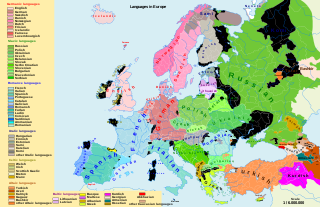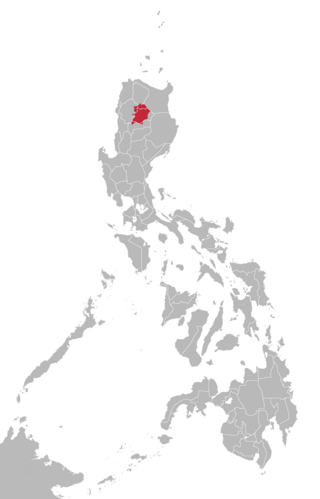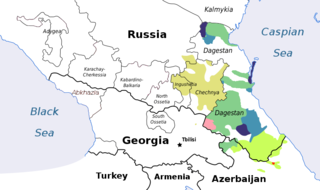
There are over 250 languages indigenous to Europe, and most belong to the Indo-European language family. Out of a total European population of 744 million as of 2018, some 94% are native speakers of an Indo-European language. The three largest phyla of the Indo-European language family in Europe are Romance, Germanic, and Slavic; they have more than 200 million speakers each, and together account for close to 90% of Europeans.
Wajarri is an endangered Australian Aboriginal language. It is one of the Kartu languages of the Pama–Nyungan family.
The Waorani (Huaorani) language, commonly known as Sabela is a vulnerable language isolate spoken by the Huaorani people, an indigenous group living in the Amazon rainforest between the Napo and Curaray Rivers in Ecuador. A small number of speakers with so-called uncontacted groups may live in Peru.

Kalinga is a dialect continuum of Kalinga Province in the Philippines, spoken by the Kalinga people, alongside Ilocano. The Banao Itneg variety is not one of the neighboring Itneg languages.
The Boruca language is the native language of the Boruca people of Costa Rica. Boruca belongs to the Isthmian branch of the Chibchan languages. Though exact speaker numbers are uncertain, UNESCO’s Atlas of the World’s Languages in Danger has listed Boruca as "critically endangered". It was spoken fluently by only five women in 1986, while 30 to 35 others spoke it non-fluently. The rest of the tribe's 1,000 members speak Spanish.
Chintang is an eastern Kirati languages language spoken by 5,000 to 6,000 people in Chhintang VDC and Ahale VDC in Dhankuta District, Province No. 1, Nepal. The language has two dialects, Mulgaun and Sambhugaon. Most speakers of Chintang are also fluent speakers of the Indo-European Nepali language, which is the lingua franca of Nepal and the sole language of instruction in school, and the Sino-Tibetan Bantawa language, which is closely related to Chintang. The UNESCO World Atlas of Languages classifies the language as definitely endangered.
Mabire is a critically endangered Afro-Asiatic language spoken in Oulek village in Chad.

Khinalug (also spelled Khinalig, Khinalugi, Xinalug(h), Xinaliq or Khinalugh) is a Northeast Caucasian language spoken by about 3,000 people in the villages of Khinalug and Gülüstan, Quba in the mountains of Quba Rayon, northern Azerbaijan. It forms its own independent branch within the Northeast Caucasian language family.
Asuri is an Austroasiatic language spoken by the Asur people, part of the Munda branch. Asuri has many Dravidian loanwords due to contact with Kurukh.
Cajamarca–Cañaris Quechua is a branch of Quechua spoken in northern Peru, consisting primarily of Cajamarca Quechua, and Lambayeque Quechua, near the towns of Cajamarca and Cañaris in the Cajamarca and Lambayeque regions. Cajamarca and Lambayeque Quechua have 94% lexical similarity and are mutually intelligible. Adelaar (2004) includes the dialect of Lincha District, far to the south on the border of the Lima and Huancavelica regions.
Zeem, or Chaari, is an endangered Chadic dialect cluster of Nigeria, whose speakers are shifting to Hausa. Dyarim is closely related.
Baka is a dialect cluster of Ubangian languages spoken by the Baka Pygmies of Cameroon and Gabon. The people are ethnically close related to the Aka, collectively known as the Mbenga (Bambenga).However, the languages are not related, apart from some vocabulary dealing with the forest economy, which suggests the Aka may have shifted to Bantu, with an estimated 15000 people have shifted.
Bidjara, also spelt Bidyara or Pitjara, is an Australian Aboriginal language. In 1980, it was spoken by 20 elders in Queensland between the towns of Tambo and Augathella, or the Warrego and Langlo Rivers. There are many dialects of the language, including Gayiri and Gunggari. Some of them are being revitalised and are being taught in local schools in the region. The various dialects are not all confirmed or agreed by linguists.
The Jino language constitutes a pair of Loloish language varieties spoken by the Jino people of Yunnan, China.

Palaung or Ta'ang, also known as De'ang, is a Austroasiatic dialect cluster spoken by over half a million people in Burma and neighboring countries. The Palaung people are divided into Palé (Ruching), Rumai, and Shwe, and each of whom have their own language. The Riang languages are reported to be unintelligible or only understood with great difficulty by native speakers of the other Palaung languages.
Logorik, Subori, or Saburi is a (critically) endangered language spoken in Eastern Sudan and Western Chad.
Zazao is an Oceanic language spoken in the Solomon Islands. Its speakers live on Santa Isabel Island. It is classified as “critically endangered” by the UNESCO Atlas of the World’s Languages in Danger, because its speakers usually speak the Cheke Holo language or the Zabana language.
Fwâi (Poai) is a Kanak language of New Caledonia, spoken in the commune of Hienghène. In 2009, there were around 1,900 speakers of Fwâi. It’s considered a vulnerable language by the UNESCO Atlas of the World’s Languages in Danger.
Chigmecatitlán Mixtec is a Mixtec language of Puebla, Mexico, spoken in the municipalities of Chigmecatitlán and Acatlán de Osorio. This language is also known as Central Puebla Mixtec, Chigmecatitlán Mixtec, Mixteco de la Frontera Puebla-Oaxaca, and Mixteco de Santa María Chigmecatitlán.




